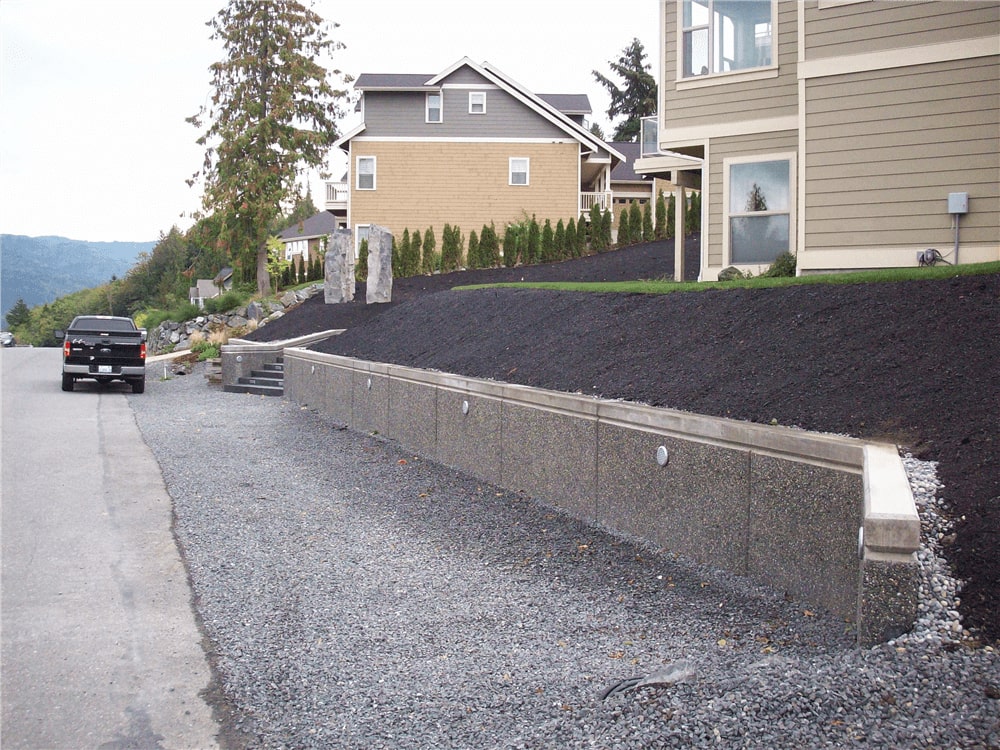What is the purpose of retaining walls?Retaining wall blocks or concrete are commonly found around houses and commercial buildings throughout the United States. They play key roles in protecting homes and other land structures from flooding in heavy rain. But why do builders install them? What exactly does their function entail? Although they look simple, these concrete block walls are built to withstand lateral pressure through their base slab and counter forts. Their main objective is to prevent the flow of rainfall into basements and crawl spaces. The retaining wall slab blocks come in various sizes and shapes. Some are designed to contain water and drain slowly, while others are meant to stop water completely. Retaining Wall DesignThe style of a retaining wall depends on several factors, including its location, size, height, slope, features, and materials used. The most common types of retaining walls include: • Concrete walls – These are the simplest type of retaining walls using precast concrete. They can be made with different designs and colors. Blocks are constructed as vertical walls with depth to form a wall that can be as tall as needed. • Stone walls – A beautiful stone wall is usually more expensive than a concrete block. It requires special skills to build it properly. • Natural rock walls – These are also known as natural stone walls. They are constructed using rocks that have been shaped by nature. • Masonry walls – This type of wall uses bricks or stones that have been cut and fitted together. • Wood walls – These are popular for landscaping purposes because they are easy to construct and maintain. Types Of Retaining WallsThere are three basic types of retaining walls: 1. Gravity walls – These are the easiest retaining wall to build. The traditional gravity wall holds back soil and debris. 2. Pressure-compensating walls – These are the most complex retaining walls. In this case, the wall construction is not only designed to resist the force of the water but also to compensate for the weight of the earth above it. 3. Self-supporting walls – These are the strongest type of retaining walls. Its strength comes from the fact that it has no external support. Different functions of retaining walls for residential and commercial propertiesRetaining walls serve many important functions for the backyard, terrace, or any other areas where they are constructed. Here are some of the most common ones: • Protecting foundations – When a house floods, the foundation becomes damaged. Water seeps through cracks in the foundation and enters the basement, resulting in drainage issues. If the foundation is protected by a retaining wall, then the water will run off instead of entering the home. • Preventing erosion – Erosion occurs when water flows over excess soil or loose soil. It causes the land to erode away. Retaining walls help protect against erosion by preventing water from flowing downslope due to the pressure of soil. • Supporting slopes – Slopes are steep hillsides that are prone to landslides. Well-built retaining walls provide stability to slopes so that they don’t collapse. • Controlling runoff – Rainwater runoff is one of the biggest problems facing urban areas. Retaining walls reduce the flow of water that runs off the property. • Providing privacy – Privacy is an essential part of any home. Retaining walls with heights create a buffer between property lines. How do retaining walls stop water and prevent soil erosion?A retaining wall is a barrier that prevents water issues through soil improvement operations. To accomplish this, it must contain at least two layers: a base layer and a top layer. The base layer should be placed below grade level (below the ground). The top layer should be placed above grade level (above the ground). The base layer consists of suitable materials like large boulders, gravel, or other heavy objects that serve as soil reinforcements. The top layer consists of smaller stones or blocks that are used to fill up the space between the boulders and tight spaces. When the water hits the boulder, it slows down and begins to flow around the boulders. As it moves along, it picks up speed and eventually reaches the top layer. At this point, the water can either continue to move downward or turn around and go back uphill. Various materials are used in retaining walls to serve as proper drainage for outdoor spacesThere are several different materials that can be used for wall installation. Some of these include: • Gravel – This granular material is made up of small pieces of stone. It is usually mixed with sand and cement to make concrete. • Concrete – This is a mixture of cement, sand, and water. It is poured into forms and allowed to harden. • Stone – This is another popular choice for retaining walls. It is available in a variety of sizes and shapes, so it can become a decorative feature. • Brick – This is a brick-like heavy material that is often used to build retaining walls. • Masonry block – This is a building block that is used to construct retaining walls. • Cement – This is a powdery substance that is mixed with water to form concrete. • Wood – This is a common material used to build retaining walls because it is inexpensive. It comes in many different types, including cedar wood, redwood, and pressure-treated pine. Are retaining walls necessary?Retaining walls are not only useful but also necessary if you want to have a beautiful landscape. They can be built on flat surfaces or sloped terrain. A retaining wall can also be constructed using natural rock formations as an additional landscaping feature, such as cliffs, bluffs, and mountains.
If you live near a landscape where there are steep slopes, rivers, streams, lakes, ponds, or oceans, you may need to install a retaining wall to keep them out of your yard. You may also need to build a retaining wall if you live near a slope that has been eroded by wind or water. The aforementioned styles of walls in this article will help you choose the types of material and the perfect retaining wall for your usable space. Their primary function is to act as a cohesive strength to prevent water uplift and improve concrete footings. If you plan to build a retaining wall, you will first need to determine whether you need a temporary or permanent structure. Temporary structures are usually made of wood or metal. Permanent structures are typically made of masonry. Temporary structures come in handy for wall projects when planning to build a new house or remodel an existing one. These structures can be dismantled after the project is completed. Permanent structures are more durable than temporary ones. However, they require more time and effort to construct. If you do not have enough time or money to complete the project, you might consider hiring a professional landscaper to help you build a retaining wall.
2 Comments
8/30/2022 12:59:05 pm
I thought it was interesting when you pointed out that a retaining wall can help you have a beautiful landscape. It seems like you would want to have a beautiful landscape if you are wanting to improve the value of your home. People really value the exterior of a home, so it seems like investing in a retaining wall is a beneficial thing to do.
Reply
9/13/2022 08:58:57 pm
Thank you for sharing this informative article about concrete retaining walls. I hope there are a lot of contractors who could read this and be guided accordingly.
Reply
Leave a Reply. |
|

